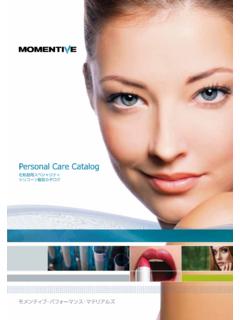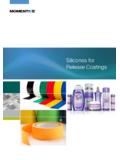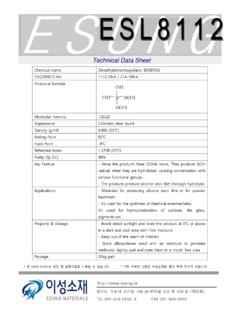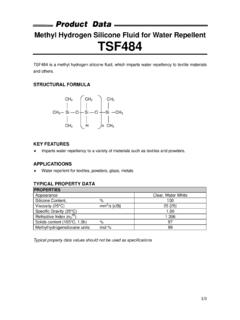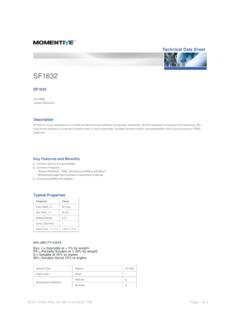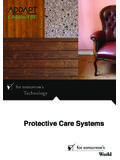Transcription of Silwet* Copolymers Chameleon Solutions
1 Silwet* Copolymers Chameleon Solutions Chemical chameleons - Amazing - Quick - change 3. chemistry Chemical Chameleons 4. Wetting 4. Spreading 5. Gloss, Release, Antiblock 6. Foaming & Defoaming 6. Emulsifiers & Dispersants 6. The Silwet* Copolymer Portfolio 7-9. Silwet Triangle - a decision-making tool 10-11. Additional Product Information 12-17. 2. Chemical chameleons - Amazing - Quick - change chemistry How do you transform a product from good enough to superior? What chemical solution is versatile enough to push formulations ahead in virtually every performance category? The answer is Silwet* Copolymers - whether you manufacture fuel additives, cleaners, rain-guards, lubricating fluids, release agents or polymers. Ordinary siloxanes are chemically limited. By contrast, Silwet Copolymers offer virtually unlimited capabilities.
2 Through ingenious transformations. Through synergy. Through attraction, repulsion and molecular interaction. Their chemical adaptation at the surface and beneath. And the potential is hiding right before your eyes. 3. Silwet* Copolymers - Chemical Chameleons How deep an active penetrates a substrate, how evenly paint wets a surface, how well particles get dispersed in a formulation or how far and thin an aqueous product spreads on a leaf can make the difference between success and failure. Our Silwet Copolymers can provide this difference. They have high surface activity and can reduce the interfacial tension dramatically at very low addition levels. Due to the combination of different chemistries - which each add their respective set of properties they can adapt to a multitude of needs and environments. This makes them like chemical chameleons.
3 Silwet Copolymers - Wetting To provide efficient coverage, a formulation must stay evenly distributed on a surface. You find insufficient wetting or dewetting if a formulation retreats from a surface leaving uncovered areas or craters. Silwet Copolymers can significantly reduce the surface tension of formulations. This means that in most cases formulations containing small amounts of Silwet Copolymers spread easier and more evenly on surfaces or penetrate substrates more deeply compared to the same formulation without. Also, many low surface energy substrates - especially those with sharp edges - are difficult to cover. Here Silwet Copolymers can provide the solution! The reason is the low surface tension contribution of the silicone portion of the polymer. However, unmodified silicone is not soluble in water or polar solvents like methanol or ethanol.
4 By attaching polyalkyleneoxide, we design Silwet Copolymers to achieve highest solubility, while maintaining the benefits of the silicone. We do provide a selection of products to support both aqueous and non-aqueous formulations, combined with a unique set of properties, depending on your requirements such as, a water soluble product that supports foam or, alternatively, helps to suppress it. 4. Silwet* Copolymers - Spreading While wetting can be achieved by applying a formulation on a surface by brush, roller or blade, in the case of spreading the formulation proactively spreads onto a surface on its own. This is especially useful to reduce application time or if a formulation is applied by spray. While all spreaders are wetting aids, not all wetting aids provide spreading. In general, spreading increases with lower surface tension, but that is not the only factor.
5 Size and structure of the surfactant molecule also play key roles in spreading your product across a surface or into a substrate. Due to their special design, Silwet trisiloxane Copolymers and Silwet Hydrostable*. Copolymers provide excellent spreading performance and thus are referred to as superspreaders (Figure 1). Most common use levels in the range from to weight-% are sufficient to achieve the desired effect. 2s 40s water Silwet L-77 spreader Silwet L-7602 surfactant 10s 50s 20s 60s Figure 1: Comparison of the spreading behavior of water, weight-% Silwet L 7602. surfactant and weight-% 30s 70s Silwet L-77* Spreader on polyethelene (PE) surface. Note: Test results. Actual results may vary. 5. Silwet* Copolymers - Gloss, Release & Antiblock Silicone is known to provide excellent release and lubricity, especially for rubber-to-rubber, plastic-to-plastic or plastic-to- steel friction.
6 For waterborne applications silicone emulsions are often used. These are white emulsions prone to creaming and separation, especially if diluted to low active content ( to 5. weight-% are most commonly used). Silwet Copolymers translate this benefit of lubricity into a stable, soluble or dispersible form. In contrary to common emulsions no additional components - like emulsifiers and thickeners are needed. Where the silicone component dominates, another silicone property also comes into the foreground a glossy appearance or color deepening effect on plastic surfaces, known from many polish formulations and conditioning agents. Again the water compatibility of Silwet Copolymers allows formulating gloss providing products without the need to add other additives, which might diminish the effect. Silwet Copolymers .
7 Foaming & Defoaming The secret to stabilizing foam lies in the interface between the liquid and the entrapped air. Profoamers stabilize this interface preventing the bubbles from bursting. Defoamers destabilize the barrier forcing the air to escape more quickly. Silicone due to its low surface tension is attracted to this interface and destabilizes it. Thus Silwet Copolymers with a high silicone content act as defoamers, while the ones with low silicone content and high water solubility act as foam stabilizers. Silwet Copolymers . Emulsifiers & Dispersants Our specialty surfactants go straight to the oil/water or particle/. water interface where stability is essential to prevent or delay separation. They are especially useful to compatibilize silicone based products or silicone coated particles, like many pigments.
8 Their low surface energy makes them effective at low dosage and their high molecular weight keeps them at the interface and protects them against aggregation. to weight-% addition level, based on the weight of the dispersed phase are good starting levels. The finer the achieved particle size of the emulsion droplets or the larger the surface of the particle to disperse, the more Silwet copolymer is needed. In many cases Silwet Copolymers act synergistically with other organic emulsifiers, so your product can hold up for longer periods of time. 6. The Silwet* Copolymer Portfolio Most Silwet Copolymers are block Copolymers of silicone, ethyleneoxide (EO) and/or propyleneoxide (PO). Typically they either have a pendant graft structure (Figure 3) or a linear (ABA)-structure (Figure 4). The composition depends on the respective magnitude of the variables x, y, m and n.
9 A molecule with significant silicone content will exhibit lubricity ( fiber lubricants), release (shear stable, water based release agents) coefficient of friction reduction ( assembly of plastic parts), slip, mar resistance, gloss and sheen in polish applications and moderate foam control. A product with high polyethyleneoxide content will be self-dispersible or soluble in water or polar solvents. It reduces the interfacial tension and thus aids the wetting, flow and leveling of formulations based on such solvents. A material of high polypropyleneoxide content will be self-dispersible or soluble in non-polar solvents. It reduces the interfacial tension of such solvents and thus aids the wetting, flow and leveling of formulations based on such solvents. It will often perform as a foam-control and deaeration agent (anti-cratering).
10 Silicone Lubricity Low interfacial Tension Defoaming Silwet* Copolymers Ethyleneoxide Propyleneoxide Water Solubility Oil Solubility Profoaming Defoaming Wetting Deaeration 7. Silwet* Trisiloxanes are a special case within the Silwet Copolymers of the pendent graft structure type (Figure 5). These materials are referred to as superspreaders, because they provide active spreading and penetration, especially to waterborne formulations (Figure 2). Though their exceptional benefits make trisiloxanes one of the most commonly used type of silicone surfactants, they have one weakness: they degrade outside neutral pH conditions over time. Figure 2: Contact angle measurements on polystyrene of (I). water and aqueous Solutions of (II) weight-%. Octylphenolethoxylate and (III) weight-% Silwet L-77* Spreader. To overcome this we invented the Silwet Hydrostable* product series, which combine the excellent spreading and wetting performance of the well-known Silwet trisiloxanes with stability ranging from pH-value 2 to 12.

